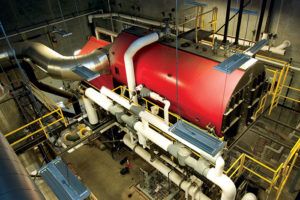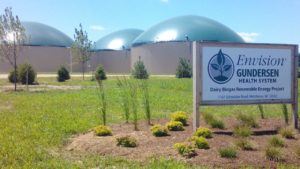Gundersen Under the Sun

The future of climate-friendly hospitals: what Gundersen Health is doing to keep it clean
When asked to describe healthcare in the United States, what words spring to mind? “Costly”? “Inefficient”? “Low quality”?
Or perhaps you’ve managed to avoid the long waits in the ER, and are the proud owner of a Cadillac high deductible health plan. Then “accessible”, “comprehensive”, or “innovative” might sit a little better.
Now, how about “polluting”? For many, it likely isn’t top of mind. After all, hospital floors are as white and sterile as they come, right?
A 2016 Yale study found that if the US healthcare industry were a country, it would rank 13th in the world for Greenhouse Gas Emissions, responsible for 655 million tons of CO2-equivalents in 2013. This equates to 9.8% of the US total [1]. Not only are healthcare services and goods (including pharmaceuticals and devices) highly energy-consuming, hospital facilities use more than twice as much energy per square foot as traditional office spaces [2]. This can be explained by the facilities’ size and round-the-clock overhead (e.g. lighting and HVAC).
Drilling down a little further, the impact of climate change on hospitals in particular is enormous. For one, brown energy consumption will become more expensive. In addition, the impacts on human health will continue to burden an already strained health system. Elevated temperatures will increase the incidence of heat-related deaths, reduced air quality will exacerbate cardiovascular and respiratory illness as well as allergies, and rising water temperatures will increase vector-, food- and water-related infection risk [3].
Leading the charge in sustainably delivering care is Gundersen Health System, a not-for-profit integrated-delivery system based in La Crosse, Wisconsin. In 2008 the organization developed its sustainability program, Envision, which set out to achieve “energy independence” by 2014 through energy management, waste management and control, and recycling / reusing / remanufacturing. “Energy independence”, meaning the generation of more energy renewably than is consumed via fossil fuels, was achieved in October 2014 [4].
As part of its energy management plan Gundersen invested in a portfolio of renewable energy projects, running the gamut from solar, gas-to-energy, wind, biomass, to geothermal.
Partnering with La Cross county, they were able to convert enough landfill biogas into electricity and heat to power one of their hospital campuses. Another significant collaboration is with Organic Valley, the national farmer-owned organic co-op, to run two wind turbine sites, generating over 10 million kW hours per year, equivalent to the energy extracted from 1 million cubic metres of natural gas. And generating over a third of Gundersen’s total energy need is a biomass boiler installed on campus that uses clean organic wood fuel sources. Other renewable energy sources include: geothermal heat pump system, solar photovoltaic and hot water systems, and dairy manure digesters [5].


To add to the overwhelming success of its renewable energy projects, Gundersen’s efforts to manage waste and remanufacture / reuse equipment and devices saved them over $500,000 annually. In all, the Evision grid generated 26M kWh per year, representing $1.8M in savings in 2014, and a total of $5.8M since 2008. [6]
Granted, these green innovations don’t come cheap. Gundersen spent $40M in total on its renewable energy plan and $2M on energy conservation in 2008. Importantly, $11M in local, state, and federal grants were delivered in support of the effort.
Going forward, there is a significant opportunity for government entities and NGOs to invest further in sustainable healthcare delivery. Perhaps more immediate is the need for greater collaboration between hospital networks. Indeed, Envision has already facilitated other large systems to save in excess of 20% of their energy costs by sharing its own best practices around conservation. We are also seeing consortia like Health Care Without Harm and the Healthier Hospitals Initiative commit health systems to reduce their carbon footprint in the near term.
In April 2015 Gundersen joined Health Care Without Harm’s 2020 Healthcare Climate Challenge, an international call to action for hospitals to increase environment responsibility in their operations, increase climate resilience and readiness for shifts in disease burden related to climate change by working with public health departments, and educate physicians, nurses and the public about the link between health and climate change. [7]
In addition to continued involvement in these initiatives, there remains the opportunity to align its supply chain to its goals around health and climate change. For example, Gundersen could consider partnering with suppliers with superior green fuel standards, or outlining purchasing preference for energy efficient shipping.
Gundersen sets the standard for prioritizing and delivering sustainable care. But there is a high price to pay for complacency in promoting environmental health, and helping to reframe the discussion around climate change from purely a health issue to an environmental one.
[Word count: 767]
[1] “Environmental Impacts of the U.S. Health Care System and Effects on Public Health.” PLOS. http://journals.plos.org/plosone/article?id=10.1371/journal.pone.0157014#sec003. 9 June 2016. Web. accessed Nov 2016.
[2] “2012 Commercial Buildings Energy Consumption Survey: Energy Usage Summary”. US Energy Information Administration. http://www.eia.gov/consumption/commercial/reports/2012/energyusage/. 18 March 2016. Web. Accessed Nov 2016.
[3] “Climate and Health Assessment”. US Global Change Research Program. https://health2016.globalchange.gov/. Nd. Web. Accessed Nov 2016
[4] “Hospitals shift from fossil fuel to renewable energy sources”. Modern Healthcare. http://www.modernhealthcare.com/article/20141108/MAGAZINE/311089981. Nov 8, 2014. Web. Accessed Nov 2016
[5] Company website. http://www.gundersenenvision.org/renewable-energy. Envision Gundersen Health System. Nd. Web. Accessed Nov 2016
[6] “Best Practices Sustainability, Innovative Advances in Sustainability: Gundersen Health System”. Wisconsin Business. https://www.wmc.org/wp-content/uploads/Env-Sustainability_Gundersen-Health-System.pdf. 27 April 2015. Web. Accessed Nov 2016
[7] “2020 Health Care Climate Challenge”. Healthcare Without Harm. https://noharm-global.org/issues/global/2020-health-care-climate-challenge. Nd. Web. Accessed Nov 2016
[Exhibit 1] “Green Health Systems Embrace Renewable Energy”. Health Facilities Management. http://www.hfmmagazine.com/articles/2234-green-health-systems-embrace-renewable-energy . 6 July 2016. Web. Accessed Nov 2016
[Exhibit 2] “Gundersen’s Dairy Biogas Renewable Energy Project”. https://www.youtube.com/watch?v=C_WaXhbqEjA . 19 Nov 2014. Web. Access Nov 2016



This was an eye-opening post that effectively highlighted the glaring contradiction between healthcare and the environment. As a society, we have grown to expect healthcare services at any cost, but the resulting pollution and waste directly contribute to harming the overall health of the population. In a similar vein, I wonder if a cultural shift within the healthcare system is required to embrace sustainability initiatives. Medical providers often play a critical role in resource decisions and present a great opportunity for waste reduction. Seemingly insignificant changes in how services or supplies are utilized and delivered can aggregate into substantial benefits in resource conservation and public health. Going forwards, perhaps institutions and hospitals can better educate providers on the impact of wasteful, low-value-added practices and perpetuate a culture of conservation across all staff.
Great post! It’s interesting to hear about some of the cool things going on at Gundersen. That said, I must confess I’m a bit cynical about the prospects of applying this model elsewhere. Health systems are already under a lot of strain because of so many massive change efforts going on in the industry — the shift to bundled payment models, meeting EHR meaningful use requirements, shoring up defenses against hackers / identity thieves, etc. It’s hard for me to imagine hospitals investing this heavily (40M) in a project that isn’t required by CMS / the government and will require so many years to recover the investment. I guess I just have to wonder what was unique about Gundersen that allowed them to do this.
As SM mentions, environmental altruism and investment is not necessarily top of mind for hospitals juggling regulations, contracting, disease outbreaks, and the like. However, I would think hospitals and climate change more from an energy approach. As Ben notes, hospitals consume energy running large facilities around the clock. Given their narrowing margins, perhaps hospitals can continue to decrease their energy costs to open up profit opportunities a little further. For instance, hospitals can ensure computers have sleep-modes enabled, can use light sensors, can schedule HVAC system servicing, and can use more efficient lights. While I know little about heat-capture, apparently incineration systems’ heat can be captured to produce savings, as the University of Michigan did to the tune of $400,000 annually – this does not strike me as an easy win, but exemplifies the creative solutions not only to benefit the environment but also the bottom line.
Also, a chart in Figure 2 of the U.S. Energy Information Administration (source [2]), shows interesting opportunities in conservation; the largest are HVAC maintenance and lighting conservation, but also options like multi-layer glass windows. Therefore, a hospital can be creative in how it makes a dent in climate impact while impacting its bottom line.
Sources:
[1] https://www9.nationalgridus.com/non_html/shared_energyeff_hospitals.pdf
[2] https://www.eia.gov/consumption/commercial/reports/2007/large-hospital.php
Great post! Hadn’t ever thought about the climate impacts of the health care industry, but it makes sense that they would be heavy energy users. One big question that this post raised for me was how replicable Gunderson’s initiatives would be in other markets. I’m not convinced that all of what works in Wisconsin translates to big urban hospitals (dairy manure digesters seem a little less successful here). However, I do think some of the initiatives around managing waste and reusing equipment could be applied across geographies. I also wonder if all the simplest fixes have already been addressed or not — for instance, are hospitals today all running with more efficient lighting systems (such as LED) rather than traditional flourescents?